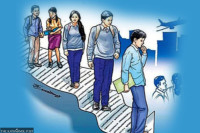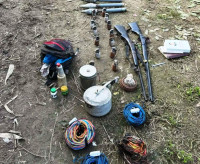National
Not much has been done to address problem of invalid votes
Local level polls are just two months away, but the Election Commission has yet to start voter education, which can hugely reduce the number of votes that go void.
Binod Ghimire
Krishna Ram Bhattarai of Matepani, Pokhara has participated in various elections in the past and he is pretty excited about exercising his franchise in the local level polls scheduled for May 13.
The 67-year-old retired government surveyor, however, admits that despite casting votes multiple times, he finds ballot papers quite confusing.
Bhattarai himself worked as a volunteer during the 2017 elections and he says many voters in his locality were not quite confident. “I sensed that there was a lack of voter education,” he told the Post over the phone.
Nepal reported a high rate of invalid votes in the last local and federal elections held in 2017. On an average, around 17 percent of votes were invalid in the local elections. In the parliamentary elections, more than 14 percent of votes were invalid.
An election in general is considered successful if the voter turnout is high and invalid votes are minimal. This is where voter education plays a significant role.
Various agencies that observed the last elections had pointed out the failure on the part of the Election Commission to conduct voter education campaigns effectively for the high percentage of invalid votes. They said the commission should stop waiting till the last moment to launch a voter education campaign and must conduct it regularly as part of civic education.
Local elections are now just a little over two months away. But the Election Commission has yet to start voter education.
“We will implement effective voter education programmes using audio-visual medium rather than wasting resources on pamphlets and papers,” Shaligram Sharma Poudel, spokesperson for the commission, told the Post. “However, we are yet to finalise the contents and dates to start voter education campaigns.”
Voter education basically has three components. Teaching people how to–register for a vote, put the stamp on the ballot paper at the place within the space containing the symbol of the candidate of choice and fold the ballot paper before putting it into the ballot box. Experts say every citizen must be made aware of how their valid votes are going to contribute to the final result in the election.
According to the Election Commission, out of the 10,579,739 votes cast under the proportional representation category in the 2017 election for the House of Representatives, 1,560,432 votes—14.74 percent—turned out to be invalid.
Similarly, around 17 percent of votes were invalid in the local elections, which were held in three phases.
The share of invalid votes in some areas like in Biratnagar Metropolitan City and Krishnanagar Municipality, Kapilvastu stood at 22 percent while it was 17 percent in Lalitpur Metropolitan City in the Capital.
Kapil Shrestha, chairperson of the National Election Observation Committee, said internationally, three percent is considered the normal threshold for invalid votes.
Shrestha, who also is a former professor of political science at the Tribhuvan University, said despite the fact that Nepal’s invalid votes are multiple times higher than the normal threshold, the commission is focusing more on imparting “voting information” than “voter education.”
“Under voter education, people are also given information on why to vote and how important their vote is,” he said. “However, the commission appears to be teaching just the voting technique. And when it is done in a hurry, such voter education becomes completely ineffective.”
Invalid votes are as good as absentations and both make a similar impact on the final result. The only difference is invalid votes make it to official records.
In the traditional ballot papers, which the Election Commission will be using for the upcoming elections, it cannot be determined whether an invalid vote is cast deliberately or by mistake. Some say since Nepal has yet to adopt NOTA (none of the above), some voters might make their votes invalid deliberately. But there is no way to determine it.
Shrestha says the high number of invalid votes is a major cause for concern, but the authorities have failed to pay proper attention to it.
Experts say there are multiple reasons that lead to invalid votes—from ineffective voter education to the structure of the ballot paper and lack of enthusiasm among voters to participate in education campaigns. A simple mistake like stamping over the election symbol or stamping outside the box can make a vote invalid.
Due to a high number of candidates, the Election Commission has to come up with large ballot papers, which can make the voters confused.
As many as 80 parties have been registered with the commission to participate in local elections. Nepalis will be electing new local representatives for 753 local units in a single phase on May 13.
Shrestha said while the commission is primarily responsible for voter education, it is also the responsibility of political parties, civil society and the media to educate the voters.
During the last elections, the commission had mobilised volunteers who reached out to the people at their doorsteps. The commission also distributed pamphlets and broadcast audio-visual contents through different media outlets. But still, the number of invalid votes was too high, and going by that trend, experts do not rule out the same this time also.
“Given the high number of invalid votes that we have seen, we can imagine how they could have impacted the election result in many places,” said Pradip Pokharel, chairperson of the Election Observation Committee Nepal. “This is a serious issue but has failed to get enough attention. The commission seems to have not learned anything from past experiences.”
Commission officials say they are working to develop the content for voter education programmes, which will start from the second week of April.
Bhattarai, the voter, says authorities must deploy volunteers so that everyone can be made aware of the voting process as well as the electoral system so as to reduce the number of invalid votes.
“Polls are near but I am not seeing that happening,” said Bhattarai. “Some knowledge like how to vote properly needs to be imparted partially. Information on television and radio alone cannot be effective.”
The commission, however, is unlikely to deploy volunteers like in 2017, given the funds constraints.
The government has sanctioned R250 million for voter education this time against Rs 750 million allocated in the previous local elections, according to the Election Commission.
“We will mobilise two volunteers each per voting booth on election day and a day before to teach the voters on casting their votes properly,” Surya Aryal, chief of the Voter Education Department at the commission, told the Post. “Instead of mobilising volunteers for a month, we will use different media outlets, social media and caller ringback tones to educate voters.”
Anup Ojha contributed reporting.




 19.12°C Kathmandu
19.12°C Kathmandu

%20(1).jpg&w=200&height=120)













